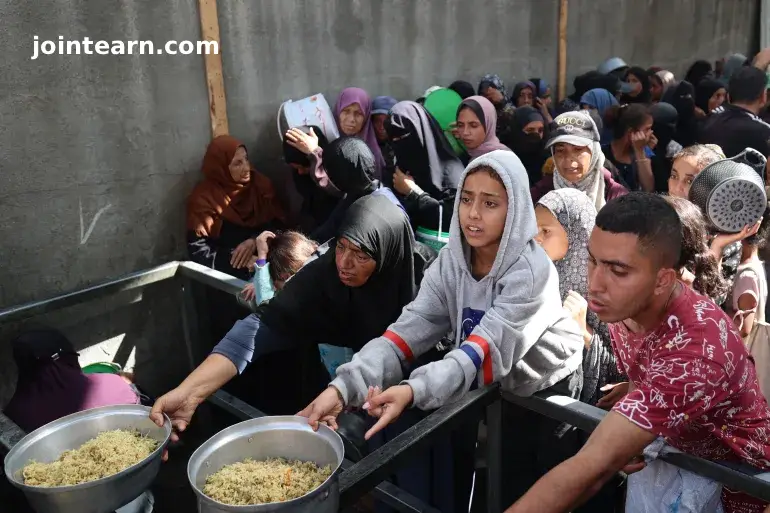
The United Nations World Food Programme (WFP) has warned that food deliveries to Gaza remain drastically below required levels, urging Israel to open additional border crossings to prevent famine in the war-torn enclave. Despite an increase in aid since the U.S.-brokered ceasefire, the amount of food entering Gaza is still less than half the WFP’s target, leaving millions of Palestinians facing extreme hunger.
WFP: Aid Levels Still Far Below Goal
According to the WFP, around 750 metric tonnes of food are currently entering Gaza each day — far below the daily target of 2,000 tonnes needed to meet the population’s basic needs after two years of devastating conflict.
“To be able to get to this scale-up, we have to use every border crossing point right now,” said Abeer Etefa, WFP spokesperson, during a press briefing in Geneva on Tuesday.
Etefa noted that only two Israeli-controlled crossings — Karem Abu Salem (Kerem Shalom) in southern Gaza and al-Karara (Kissufim) in central Gaza — are currently open. The limited access, she warned, has made it impossible to reach northern areas where hunger and malnutrition are most severe.
Ceasefire Key to Averting Famine
Etefa emphasized that maintaining the ceasefire, brokered by U.S. President Donald Trump, is crucial to saving lives.
“Sustaining the ceasefire is vital; really it’s the only way we can save lives and push back on the famine in the north of Gaza,” she said.
Trump’s 20-point peace plan for Gaza includes the promise of “full aid” deliveries. However, on the ground, humanitarian organizations report persistent restrictions and delays at Israeli checkpoints.
An Israeli security official told Reuters that aid continues to enter through Karem Abu Salem “in accordance with the plan,” but did not specify if or when more crossings would open.
Food Distribution Expanding but Insufficient
The WFP has increased its presence in Gaza, operating 26 food distribution points, up from only five last Friday. However, this remains far below the agency’s goal of 145 distribution sites across the territory.
Most aid stations are currently located in southern and central Gaza, areas more accessible under Israeli military oversight. Northern Gaza, which endured the heaviest bombardment during the war, remains largely unreachable due to damaged roads, ongoing security concerns, and Israeli restrictions.
“We haven’t had large-scale convoys into Gaza City or the north of Gaza,” Etefa explained, adding that the WFP has not been permitted to use the main north-south Salah al-Din Street, a critical route for delivering aid.
Humanitarian Crisis Deepens as Borders Stay Closed
The humanitarian situation has been worsened by Israel’s decision to keep the Rafah border crossing with Egypt closed, Prime Minister Benjamin Netanyahu said on Saturday. The reopening, he stated, will depend on Hamas handing over the bodies of deceased Israeli captives.
In response, Hamas’s Qassam Brigades announced Tuesday that it would hand over the remains of two Israeli captives exhumed earlier in the day. The group has so far delivered 13 of the 28 bodies it pledged to return under the ceasefire deal.
While some nutritional supplies for children and pregnant women have reached northern Gaza through limited convoys, the amount remains inadequate.
“Food supplies delivered so far are enough to feed about half a million people for two weeks,” Etefa said. “Many families are rationing what little food they receive because they are not confident the ceasefire will hold.”
Images from the Nuseirat refugee camp show Palestinian children gathering for charity meals, highlighting the scale of dependence on humanitarian kitchens amid continuing shortages.
Aid Agencies Warn of Looming Famine
Despite international pledges of assistance, Gaza’s food crisis continues to worsen, with aid agencies warning of mass starvation if border restrictions are not lifted soon.
WFP officials have urged Israel to immediately open more crossing points to speed up the delivery of essential goods, including wheat, oil, and therapeutic food for malnourished children.
The agency stressed that the goal is to reach the 2,000-tonne daily target to prevent further deterioration of conditions in northern Gaza, where entire neighborhoods remain in ruins and access to clean water, electricity, and healthcare is minimal.
“We are doing everything possible,” Etefa said. “But without open crossings, full access, and sustained security, Gaza’s hunger crisis will only deepen.”
Background: Two Years of War and Destruction
Since the war began, Gaza has suffered catastrophic destruction, with tens of thousands killed and nearly the entire population displaced. The territory’s infrastructure — including bakeries, farms, and warehouses — has been decimated by Israeli air strikes, leaving residents almost entirely reliant on external aid.
While the ceasefire brokered by the U.S. has provided a temporary halt to fighting, humanitarian experts warn that unless aid flow dramatically increases, famine-like conditions could return within weeks.
The WFP, UNRWA, and other agencies continue to call for safe and unhindered access to deliver aid and rebuild Gaza’s shattered food supply systems.


Leave a Reply